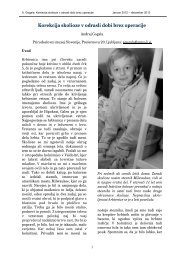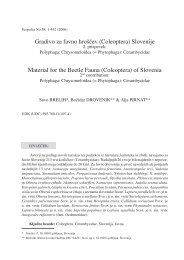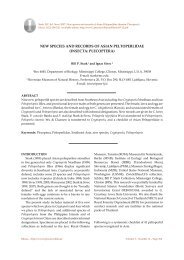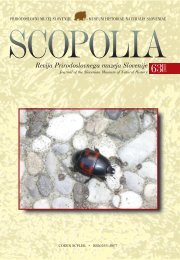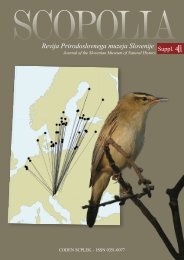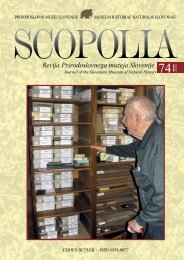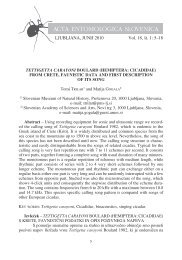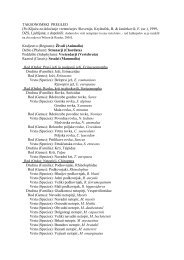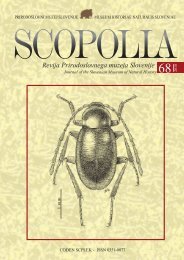Vsebina / Content (.pdf) - Prirodoslovni muzej Slovenije
Vsebina / Content (.pdf) - Prirodoslovni muzej Slovenije
Vsebina / Content (.pdf) - Prirodoslovni muzej Slovenije
- No tags were found...
Create successful ePaper yourself
Turn your PDF publications into a flip-book with our unique Google optimized e-Paper software.
Leon Senœiœ: Intensity of wing pigmentation and identification of pigments in wings of owl-fly Libelloides macaroniusthe 1mL of solution containing 0.1 mg of pure sepiapterin (Schircks, Switzerland)was applied. The solvent was n-propanol – 1% ammonium hydroxyde (2:1, V/V)(Hama et al., 1965). Developing was performed in dark. The chromatogram wasdried with warm air and checked at day light and under fluorescence at excitationwavelength 365 nm in fluorescence analysis cabinet (Spectroline CM-10, USA). Thepaper chromatography (with paper MN214, Macherey-Düren, Germany) wasperformed at the same conditions.ResultsThe yellow and black parts of wings absorb light of specific wavelengths quitedifferently, but differences between males and females at equal parts of wings werenot statistically significant (Table 1).Table 1: Absorption of yellow and black parts of the wings of Libelloidesmacaronius at wavelengths 425 and 650 nm, respectively. Values are mean ± S. D.,N = 30, * = p< 0.05.Absorption of the yellowparts of wings at 425 nmAbsorption of the blackparts of wings at 650 nmMales 2.860 ± 0.182 1.426 ± 0.176Females 2.830 ± 0.192 1.450 ± 0.135The presence of melanin was confirmed with methylene blue at pH 1 as a darkgreen coloured margins at the dark spots of the cut wings.Extraction of the yellow and black parts of wings resulted as yellow extracts withthe absorption maximum at 420 – 425 nm, characteristic for the presence of pteridines.The first extract from yellow parts had at 425 nm absorption 0.958 and from the blackparts 0.426. Absorption of the second extracts were 0.631 and 0.230, respectively.The thin-layer chromatography revealed the presence of two yellow spots (at leasttwo yellow pigments) in both extracts. The first spot with Rf 0.33 was notidentified, while the second with Rf 0.56 the length of migration corresponded tothe migration of pure sepiapterin (Figure 2). Paper chromatography (Figure 3)confirmed these results. The yellow spot with Rf 0.27 was not identified and yellowspot with Rf 0.44 was at the same position as pure sepiapterin.DiscussionSexual dimorphism of Libelloides macaronius is not marked, although the wingsof females were found to be slightly, but statistically significant larger than in themales (Devetak et al., 2002). After our absorption data the differences in intensity ofcoloration of wings were not statistically significant. Moderate low absorption of theblack spots is consequence of distribution of the black pigments only near the veins7



